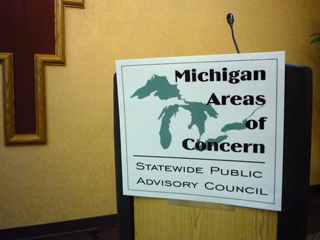
As Congress considers $475 million for Great Lakes cleanup, federal and state officals and local environmental groups discussed how to get those dollars to 14 of Michigan's most polluted sites.
By Allison Bush, bushalli@msu.edu
Great Lakes Echo
Aug. 5, 2009
Federal agencies and Michigan residents looking to clean up Great Lakes toxic hotspots planned Tuesday how to obtain a piece of the Obama Administration’s proposed $475 million environmental protection initiative.
The meeting was held at Michigan State University in East Lansing, Mich.
Michigan has 14 of the Great Lakes’ 43 Areas of Concern, or AOCs, designated by the U.S and Canada as impaired or unable to support aquatic life. Only one U.S. site, located in New York, has been cleaned to where it could be formally delisted.
“Some people feel that’s not a lot of progress over the past 20 years,” said Matt Doss, policy director for the Great Lakes Commission, who moderated the meeting. “Congress was not impressed.”
One challenge has been that most of the Areas of Concern lacked quantifiable restoration goals, Doss said. That makes it hard to determine how much progress is made.
But with the money from the restoration initiative, agencies will be able to set measurable goals, he said.
Michigan also is focusing on knocking out specific impairments associated with each Area of Concern. These limitations on beneficial uses of the lakes include frequent beach closings, a loss of fish and wildlife habitat, and restrictions on fish and wildlife consumption.
The state has removed 11 Beneficial Use Impairments from its Areas of Concern, and the Environmental Protection Agency’s goal is to remove 16 more sections by fall of 2010.
Participants were urged to apply for large and small grants by John Iliff, supervisory marine habitat resource specialist with the National Oceanic and Atmospheric Administration’s Restoration Center. Iliff reminded the crowd that large Areas of Concern, such as the Saginaw Bay, won’t necessarily get all the funding.
“When we have to show Congress what accomplishments we made in a short amount of time, if we can show a delisting of a (Beneficial Use Impairment) from a smaller AOC, we can then get more funding to move onto the bigger areas,” he said.
Improving the health of the Areas of Concern needs to be looked at from a long-term perspective, so that Congress will have an initiative to continue the funding, he said.
Several environmental agencies provided information on how they will likely divvy up the funding, which will be available through the Environmental Protection Agency’s e-mail list.
Amy DeWeerd, a Fish and Wildlife Service biologist and liaison to EPA, encouraged participants not to be shy.
“If you have fish passage problems in your AOC and you’re not sure which program to apply for, just apply to all of them and see where it goes from there,” she said.
Participants said the event helped them to understand how to request money for their projects. And they were eager to put the money to work.
“It was helpful, but what really matters is if we get the rubber to the road,” said Patty Troy, who attended on behalf of the St. Clair River Area of Concern. “If we get the money, it was great, but if we don’t, it was a waste of time.”
The $475 million initiative was passed by the House of Representatives. The Senate Appropriation Committee approved $400 million, but the full Senate has not yet taken it up.
Paulette Duhaime, who also attended on behalf of the St. Clair River, said that it was beneficial just to have the officials from the agencies hold the meeting.
“I was encouraged by them just showing up,” she said. “And it was helpful to hear more details from the agencies in what they’re looking for.”